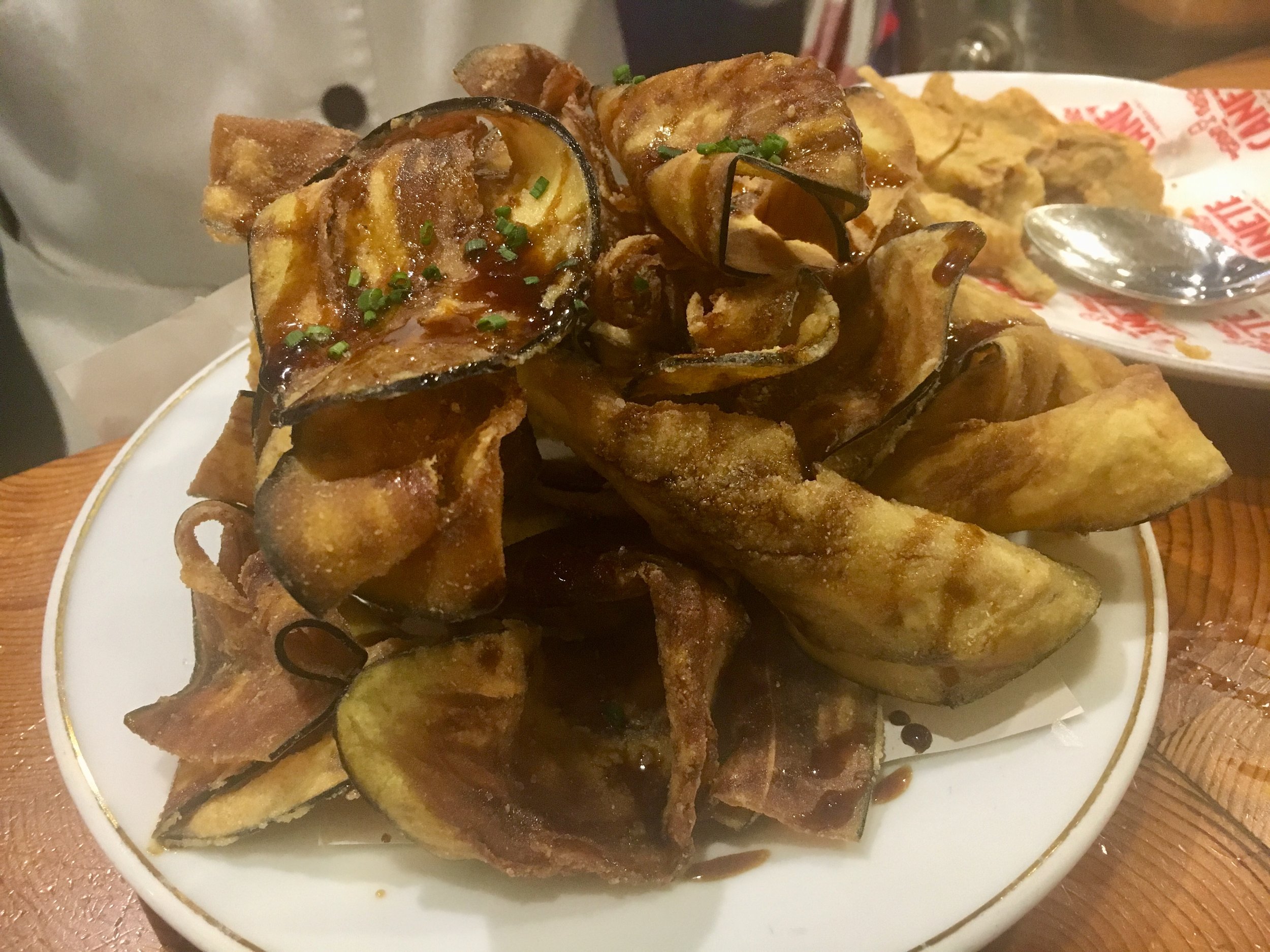It's no secret that I love eggplant, melanzana, aubergine, berenjena -- it's right there in the name of my company and blog, after all. And there are countless ways to enjoy the consumption of the glorious eggplant. What's most important is treating the berry (technically, that's what it is) with respect. Seriously! Some people laugh when I make such a sweeping statement about a nightshade -- and one which so many people claim to dislike. But that's only because they haven't had an eggplant prepared properly, which is to say with love and care and consideration. This is how I treat eggplant. And it's also how Spanish cooks treat it, particularly those in Andalucia who've been working with the eggplant since the time of Moorish rule in Southern Spain, when eggplants were introduced into the culinary lexicon and quickly became a favorite food of Iberian Jews.
This brings us to the centuries-old, incredibly delicious dish made famous in Southern Spain and now enjoyed all over the country, often served as a tapa, called berenjena con miel, or eggplant with honey. It is the perfect encapsulation of Iberian-Arab cooking with Sephardic roots. And it's the ideal savory-sweet snack one can enjoy, particularly smack in the middle of summer, when eggplant season is at its peak (though honestly, for me, it's always eggplant season!) The photo here is from an amazing dinner my husband and I shared at Bar Cañete in Barcelona last year. Each dish was better than the last, but this preparation really stood out for us both. The honey used was a deep amber local honey, and it was a really amazing experience in taste and texture, deceptively simple but layered and complex in flavor.
There are a few ways you can prepare this classic dish, varying the technique. First and foremost, the slices of eggplant need to be quite thin -- thinner than most people will be able to get with just a chef's knife -- so using a mandoline is your best bet (I've used a meat slicer in a pinch). Second, I usually salt the slices to draw out the bitterness and some of the water content of the eggplant. This also keeps it from absorbing too much oil in the frying, while seasoning the slices in advance as well. Just remember the slices must be dried before frying. I use top quality olive oil, even for frying, as do cooks in this part of the Mediterranean. Others will claim it's better to use a vegetable oil or a lighter oil with a higher smoking point, but since the ingredients are so few, the oil you use makes a big difference in the taste of the final product. So, great olive oil it is, for me.
The final question in the preparation is to flour or not to flour. You can either coat the slices in a dusting of AP flour before they go in the hot oil, or just pat them dry and toss in the pan as is. I've done both. Coating with flour makes the chips slightly more substantial, and possibly less oily, though they often don't have the light crunch and texture of a "bare" eggplant chip. Ultimately it's a matter of personal taste. Experimenting here is part of the fun! Of course, there are pretty much as many types of honey as there are flowering plants out there, so you can get innovative with the kind of honey you drizzle on top. You can change the flavor and intensity with the seasons, too. A light wildflower honey might be nice in summer, while a richer chestnut or cranberry honey might be good come autumn or winter. The only requirement is that the consistency be "drizzle-able". So, get creative!
BERENJENA CON MIEL
*2 medium-sized eggplants
*1-2 cups good quality olive oil, or other oil of choice for frying
*1 cup AP flour (optional)
*Good quality honey of choice -- must be of consistency to drizzle
*Chopped parsley or chives, optional
- Slice the washed and dried eggplant very thinly using a mandoline. Salt lightly and layer between paper towels or clean dish towels. Let sit for 20-30 minutes.
- Heat the oil of choice in a cast iton skillet or deep frying pan. Pat dry the eggplant slices and either dredge them lightly through the flour, or just place them directly into the skillet once the oil reaches temperature (it will sizzle immediately when you put the sliced eggplant in the oil).
- Cook about a minute or two on each side and flip to cook the underside. The slices should be golden brown. Drain on a paper towel-lined plate or sheet pan. Continue in this way with the rest of the eggplant slices.
- Once all the slices are fried, taste for saltiness. If they need salt, sprinkle on the fried slices. Pile on a serving platter or bowl, and drizzle generously with the honey. Top with chopped chives or parsley, if using. Serve immediately.













































